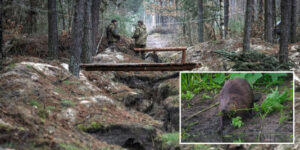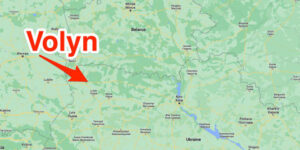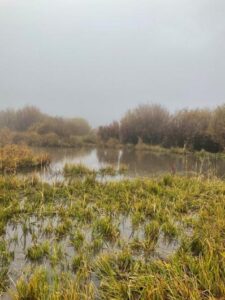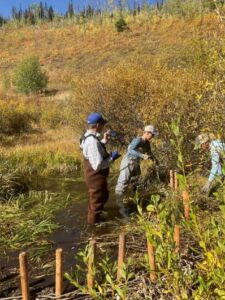Sometimes the universe feels badly about all the many depressing stories it spreads over the year and just reaches into its pocket like Santa and gives us a present. 12 people emailed to make sure I saw this yesterday and you can bet I smiled every time. As I’m sure you will now.
Ukraine credits local beavers for unwittingly bolstering its defenses — their dams make the ground marshy and impassable
Kyiv is bracing for the possibility of Russia opening a new front via the border with Belarus. But the area is tough to penetrate due to its swampy conditions, Reuters reported.
This is in part because of beavers building dams, with nobody stopping them due to the war.
 This morning its front page news in the Telegraph:
This morning its front page news in the Telegraph:

Local beavers are helping Ukraine defend itself from a potential new front in Russia’s invasion, Reuters reported on Thursday.
The animals are unwittingly helping Kyiv by building dams that keep the ground marshy and impassable, a military spokesman told the agency.
This helps Ukraine by making it less likely that an attack could come via Belarus, which borders Ukraine not far north of the capital Kyiv.
 Ukrainian officials had warned that Russia may wage an offensive through its ally Belarus into a region of Ukraine called Volyn.
Ukrainian officials had warned that Russia may wage an offensive through its ally Belarus into a region of Ukraine called Volyn.
Defense forces there, however, have been reassured by conditions on the ground, left impassable by miles of burst river banks, thick mud, and waterlogged fields.
Just you wait. Some day even our cursed skills will be appreciated!
The swampy conditions have given Ukrainians an advantage, and time to prepare: a local military unit called the Volyn territorial defense has been conducting daily training exercises in the area, according to Reuters.
Its spokesman, Serhiy Khominskyi, praised the beavers, which he told Reuters were more working unimpeded, unlike in other years.
“When [the beavers] build their dams normally people destroy them, but they didn’t this year because of the war, so now there is water everywhere,” he said.
Aaaaaaaaaaaaaaaaaand Scene!
Hows that for the vest beaver news ever? Wow the Ukrainians are really brilliant at sharing credit, I guess it’s the mark of a good leader. Make everyone feel personally invested in their victory. They sure have got it down.
 Viktor Rokun, one of the brigade’s deputy commanders, told Reuters: “On your own land, everything will help you to defend it — the landscape, lots of rivers, which have burst their banks this year.”
Viktor Rokun, one of the brigade’s deputy commanders, told Reuters: “On your own land, everything will help you to defend it — the landscape, lots of rivers, which have burst their banks this year.”
Beavers are known to be remarkable builders, using tree branches, vegetation, rocks, and mud to create dams that protect them from predators.
The unusually mild winter has created ideal conditions for Ukrainians to defend their country.
Analyst Konrad Muzyka, who runs the defense consultancy Rochan Consulting, told Reuters that Volyn would be a “horrible place to conduct an offensive operation.”
Beaver Warriors! I’m sure we all remember that horrible story from Belarus years ago where a man was bitten in the artery by a beaver and bled to death awaiting treatment. Hmmm. Seems like this watery attack was against Belarus too. Coincidence?
Maybe that was all just the first wave!




 In addition to providing outstanding wildlife habitat, freshwater marshes perform several vital ecological functions. Marsh plants capture sediments running off the land from roads, development, and farm fields and filter out excess nutrients that would otherwise degrade water quality. These wetlands store floodwaters, control erosion, and recharge groundwater supplies. Marshes also offer recreational value and are popular places for paddling, birdwatching, hunting, and fishing.
In addition to providing outstanding wildlife habitat, freshwater marshes perform several vital ecological functions. Marsh plants capture sediments running off the land from roads, development, and farm fields and filter out excess nutrients that would otherwise degrade water quality. These wetlands store floodwaters, control erosion, and recharge groundwater supplies. Marshes also offer recreational value and are popular places for paddling, birdwatching, hunting, and fishing. Tell me more about how hard wetlands are to create?
Tell me more about how hard wetlands are to create?
 Lands managed by Bureau of Land Management (BLM) are often misunderstood, and their conservation values underestimated. However, as the single largest federal public land manager, BLM has a critical role to play in addressing two inter-related crises—
Lands managed by Bureau of Land Management (BLM) are often misunderstood, and their conservation values underestimated. However, as the single largest federal public land manager, BLM has a critical role to play in addressing two inter-related crises— Faithful readers know that I have become a beaver believer. For most of the time that the Chesapeake Bay has existed, beavers by the millions inhabited every nook and cranny of the six-state watershed (and most of North America).
Faithful readers know that I have become a beaver believer. For most of the time that the Chesapeake Bay has existed, beavers by the millions inhabited every nook and cranny of the six-state watershed (and most of North America). Still, there is immense potential. Beavers are adapting to even highly developed locales; we have filmed wonderful wetlands complexes they have built behind a Royal Farms in the pavement-clad heart of Baltimore’s White Marsh-Middle River urbanization.
Still, there is immense potential. Beavers are adapting to even highly developed locales; we have filmed wonderful wetlands complexes they have built behind a Royal Farms in the pavement-clad heart of Baltimore’s White Marsh-Middle River urbanization. When beavers move in, their flooding and chewing can initially degrade forests, creating a more open, sunny complex of braided stream channels and weedy vegetation — which to many people looks messy.
When beavers move in, their flooding and chewing can initially degrade forests, creating a more open, sunny complex of braided stream channels and weedy vegetation — which to many people looks messy.



































